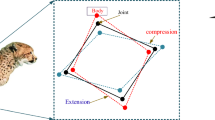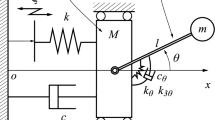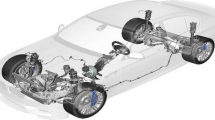Abstract
Purpose
Due to the influence of uneven guide rail, rope swing and unbalanced shaft wind pressure, the high-speed elevator car may experience violent horizontal vibration, which seriously affects the comfort and safety of elevator passengers. Hence, it is vital to suppress horizontal vibration for high-speed elevator car (HSEC).
Methods
This paper proposes a horizontal vibration active control method for high-speed elevators via acceleration feedback. First, based on passive vibration reduction, the active control is used to establish a four-degree of freedom (4-DOF) horizontal vibration model for elevator car. Then, we design an acceleration feedback-based controller for horizontal vibration response induced by guide rail excitation. The control objective functions in the multi-objective genetic algorithm are the system performance and control cost. The Pareto optimal solution set of the optimal controller parameters can be obtained only through one optimization calculation.
Results
We use the comprehensive control simulation analysis through MATLAB/Simulink to validate the vibration suppression effect for the proposed active control strategy. For the system performance, by comparing the time domain responses of no controller and using controllers C1/C2/C3, the horizontal vibration acceleration is reduced to a certain extent. The offset of the high-speed elevator car high-speed elevator car frame relative to the center of the hoistway and relative displacements between the HSEC and the HSEC frame are also reduced in a certain proportion. The control cost is employed to evaluate the control force and represents the energy consumption to a certain extent. Combining system performance and control costs, we choose C2 among the 3 sets of controller parameters, the horizontal vibration acceleration of the HSEC can be reduced by about 80%, while the power consumption is between C2 and C3.
Conclusions
The proposed optimal controller could effectively suppress elevator car horizontal vibration and significantly improve comfort while reducing the controller’s power consumption.











Similar content being viewed by others
Data Availability
All data are fully available without restriction.
References
Monge R, Rodríguez-Fortún JM, Gómez A, Roig JA, González P (2015) Design of semi-active roller guides for high speed elevators. Applied mechanics and materials, vol 706. Trans Tech Publications Ltd, Geneva, pp 108–116
Shen G, So AT, Bai H (2004) Research works on super-high-speed lifts. Elevator World 52(4):70
Jiang X, Rui Y (2015) Research on vibration Control of traction elevator. In: 2015 international industrial informatics and computer engineering conference. Atlantis Press, pp. 2144–2147
Byeongkil S, Sanghyeon Y, Heesoo L et al (2013) Mechanical properties and molecular structure of rubber materials with different hardnesses for vibration isolation of elevator cabins. J Korean Inst Metals Mater 51:713–718
Li XD, Wang K (2009) Optimization of aerodynamic characteristics of high-speed elevator. J Harbin Inst Technol 41(6):82–86
Qiu L, Su G, Wang Z, Zhang S, Zhang L, Li H (2022) High-speed elevator car horizontal vibration fluid–solid interaction modeling method. J Vib Control 28(21–22):2984–3000
Ai YT, Wang Z, Li LX (2007) Research on active vibration control technology of high-speed traction elevator. Vib Shock 26:56–58
Feng Y, Zhang JW (2007) The modeling and simulation of horizontal vibrations for high-speed elevator. J Shanghai Jiaotong Univ Chin edn 41(4):0557
Yonghui F, Jianwu Z, Xin Z, Ping S (2007) Study of active control of horizontal vibrations for high-speed elevator. Mech Sci Technol 26(8):1076
Nakano K, Hayashi R, Suda Y, Noguchi N, Arakawa A (2011) Active vibration control of an elevator car using two rotary actuators. J Syst Des Dyn 5(1):155–163
Tusset AM, Santo DR, Balthazar JM, Piccirillo V, Santos LCD, Brasil RM (2017) Active vibration control of an elevator system using magnetorheological damper actuator. Int J Nonlinear Dyn Control 1(1):114–131
Wang Z, Qiu L, Zhang S, Su G, Zhu L, Zhang X (2022) High-speed elevator car system semi-active horizontal vibration reduction method based on the improved particle swarm algorithm. J Vib Control. https://doi.org/10.1177/10775463221089425
Paulitsch C, Okamoto KI, Utsunomiya K (2003) Self-sensing active damping guide roller for elevators. VDI-Berichte, Düsseldorf, pp 91–110
Fathy HK, Bortoff SA, Copeland GS, Papalambros PY, Ulsoy AG (2002) Nested optimization of an elevator and its gain-scheduled LQG controller. In: ASME international mechanical engineering congress and exposition, vol. 36290, pp. 119–126
Santo DR, Balthazar JM, Tusset AM, Piccirilo V, Brasil RMLRF, Silveira M (2018) On nonlinear horizontal dynamics and vibrations control for high-speed elevators. J Vib Control 24(5):825–838
Zhang Q, Yang Z, Wang C, Yang Y, Zhang R (2019) Intelligent control of active shock absorber for high-speed elevator car. Proc Inst Mech Eng C J Mech Eng Sci 233(11):3804–3815
Fu WJ (2008) Research on car lateral vibration suspensions for super high speed elevators (Doctoral dissertation, Thesis, Shanghai Jiao Tong University)
Arrasate X, Kaczmarczyk S, Almandoz G, Abete JM, Isasa I (2014) The modelling, simulation an experimental testing of the dynamic responses of an elevator system. Mech Syst Signal Process 42(1–2):258–282
Yamazaki Y, Tomisawa M, Okada K, Sugiyama Y (1997) Vibration control of super-high-speed elevators: car vibration control method based on computer simulation and experiment using a full-size car model. JSME Int J Ser C Dyn Control Robot Design Manuf 40(1):74–81
Bao JH, Zhang P, Zhu CM, Zhu M, Jin LQ, Xie HX (2017) Vibration control of high-speed elevator hoisting systems based on tensioning devices. J Vib Shock 36(14):221–226
Noguchi N, Arakawa A, Miyata K, Yoshimura T, Shin S (2011) Study on active vibration control for high-speed elevators. J Syst Design Dyn 5(1):164–179
Fu WJ, Zhu CM, Ye QT (2006) Multi-objective Integrated optimization based on evolutionary strategy with a dynamic weighting schedule. J Southeast Univ (Engl Edn) 22(2):204–207
Chen BS, Cheng YM (1998) A structure-specified H∞ optimal control design for practical applications: a genetic approach. IEEE Trans Control Syst Technol 6(6):707–718
Wee H, Kim YY, Jung H, Lee GN (2001) Nonlinear rate-dependent stick-slip phenomena: modeling and parameter estimation. Int J Solids Struct 38(8):1415–1431
Van Veldhuizen DA, Lamont GB (2000) Multiobjective evolutionary algorithms: analyzing the state-of-the-art. Evol Comput 8(2):125–147
Fonseca CM, Fleming PJ (1993) Genetic algorithms for multiobjective optimization: formulation discussion and generalization. Icga 93(July):416–423
Wang L, Zhao Y, Liu J, Zhou Z (2023) Uncertainty-oriented optimal PID control design framework for piezoelectric structures based on subinterval dimension-wise method (SDWM) and non-probabilistic time-dependent reliability (NTDR) analysis. J Sound Vib 549:117588
Liu J, Wang L (2023) Two-stage vibration-suppression framework for optimal robust placements design and reliable PID gains design via set-crossing theory and artificial neural network. Reliab Eng Syst Saf 230:108956
Qin CJ, Tao JF, Liu CL (2019) A novel stability prediction method for milling operations using the holistic-interpolation scheme. Proc IMechE, Part C: J Mech Eng Sci 233(13): 4463–4475
Qin CJ, Tao JF, Liu CL (2018) A predictor-corrector-based holistic-discretization method for accurate and efficient milling stability analysis. Int J Adv Manuf Technol 96:2043–2054
Qin CJ, Tao JF, Liu CL (2017) Stability analysis for milling operations using an Adams-Simpson-based method. Int J Adv Manuf Technol 92:969–979
Acknowledgements
This work was supported by Natural Science Foundation of China (Grant No. 51935007).
Author information
Authors and Affiliations
Corresponding author
Ethics declarations
Conflict of Interest
The authors declare that they have no conflict of interest.
Additional information
Publisher's Note
Springer Nature remains neutral with regard to jurisdictional claims in published maps and institutional affiliations.
Rights and permissions
Springer Nature or its licensor (e.g. a society or other partner) holds exclusive rights to this article under a publishing agreement with the author(s) or other rightsholder(s); author self-archiving of the accepted manuscript version of this article is solely governed by the terms of such publishing agreement and applicable law.
About this article
Cite this article
Zhao, M., Qin, C., Tang, R. et al. An Acceleration Feedback-Based Active Control Method for High-Speed Elevator Horizontal Vibration. J. Vib. Eng. Technol. 12, 1943–1956 (2024). https://doi.org/10.1007/s42417-023-00955-z
Received:
Revised:
Accepted:
Published:
Issue Date:
DOI: https://doi.org/10.1007/s42417-023-00955-z




